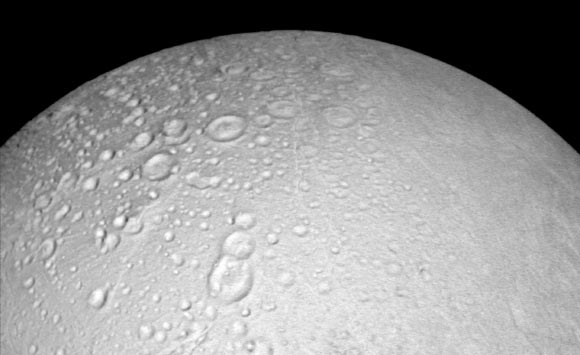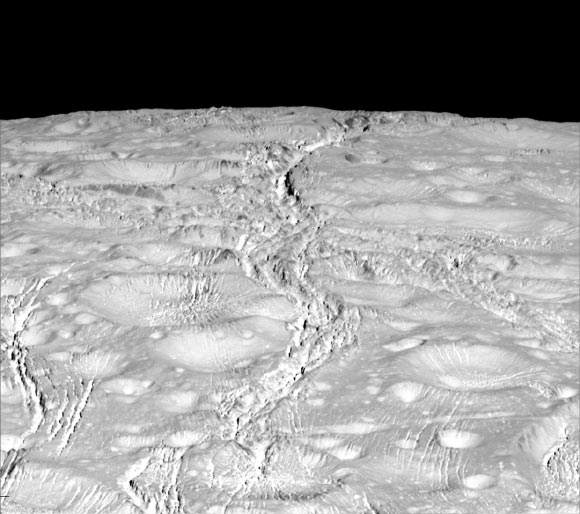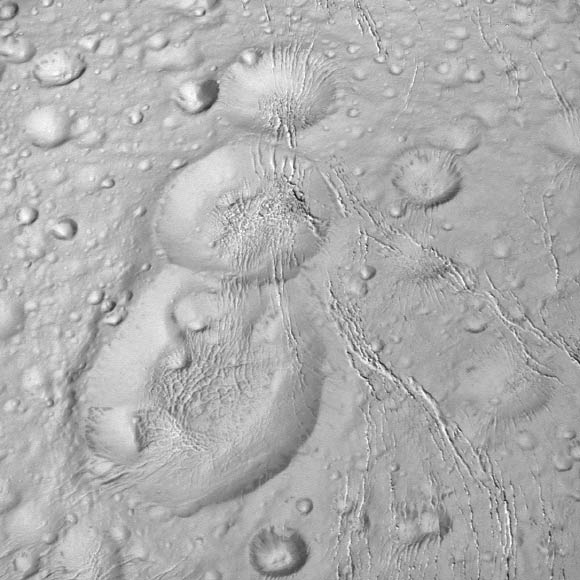NASA scientists have released the best views yet of the northern extremes of Saturn’s moon Enceladus. The images were collected as the agency’s Cassini spacecraft swept within 4,000 miles (6,000 km) of the icy moon on October 14, 2015.

This image from Cassini shows battered terrain around the north pole of Enceladus. Craters crowd and overlap each other, each one recording an impact in the moon’s distant past. The moon’s north pole lies approximately at the top of this image. North on Enceladus is up. The view was acquired at a distance of 4,000 miles (6,000 km) from Enceladus and at a Sun-Enceladus-spacecraft, or phase, angle of 8 degrees. Image credit: NASA / JPL-Caltech / Space Science Institute.
Cassini mission scientists expected the north polar region of Enceladus to be heavily cratered, based on low-resolution images from the Voyager mission, but the new high-resolution Cassini images show a landscape of stark contrasts.
“The northern regions are crisscrossed by a spidery network of gossamer-thin cracks that slice through the craters,” said team member Dr Paul Helfenstein, of Cornell University.
“These thin cracks are ubiquitous on Enceladus, and now we see that they extend across the northern terrains as well.”
Since Cassini’s 2005 discovery of continually-erupting fountains on Enceladus, the moon has become one of the most promising places in the Solar System to search for present-day habitable environments.
In March 2015, Cassini scientists announced evidence that hydrothermal activity may be occurring on the seafloor of the moon’s underground ocean. In September the team broke news that its ocean – previously thought to be only a regional sea – was, in fact, global.

Cassini captured this stunning image of Enceladus’ north pole on October 14, 2015. Mission scientists expected the north polar region to be heavily cratered, based on low-resolution images from the Voyager mission, but high-resolution Cassini images show a landscape of stark contrasts. Thin cracks cross over the pole – the northernmost extent of a global system of such fractures. Before this Cassini flyby, scientists did not know if the fractures extended so far north on Enceladus. North on Enceladus is up. The view was acquired at a distance of 4,000 miles (6,000 km) from Enceladus and at a Sun-Enceladus-spacecraft, or phase, angle of 9 degrees. Image credit: NASA / JPL-Caltech / Space Science Institute.
“The global nature of Enceladus’ ocean and the inference that hydrothermal systems might exist at the ocean’s base strengthen the case that this small moon of Saturn may have environments similar to those at the bottom of our own ocean,” said team member Dr Jonathan Lunine, of Cornell University.
“It is therefore very tempting to imagine that life could exist in such a habitable realm, a billion miles from our home.”
“We’ve been following a trail of clues on Enceladus for 10 years now,” added team member Dr Bonnie Buratti of NASA’s Jet Propulsion Laboratory in Pasadena.
“The amount of activity on and beneath this moon’s surface has been a huge surprise to us. We’re still trying to figure out what its history has been, and how it came to be this way.”

Cassini spied this tight trio of craters as it approached Enceladus for a close flyby on October 14, 2015. The craters, located at high northern latitudes, are sliced through by thin fractures – part of a network of similar cracks that wrap around the snow-white moon. The image was taken in visible light at a distance of 6,000 miles (10,000 km) from Enceladus. Image credit: NASA / JPL-Caltech / Space Science Institute.
After the October 14 flyby, only two close Enceladus flybys remain before the end of the Cassini mission in 2017.
The next encounter is planned for October 28, 2015, when Cassini will come within 30 miles (49 km) of the Enceladus’ south polar region.
During the encounter, the spacecraft will make its deepest-ever dive through the moon’s plume of icy spray, sampling the chemistry of the extraterrestrial ocean beneath the ice.
Cassini’s final close Enceladus flyby will take place on December 19, 2015, when the spacecraft will measure the amount of heat coming from the moon’s interior. The flyby will be at an altitude of 3,106 miles (4,999 km).







